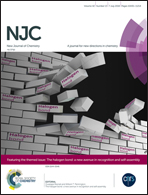Tuning the molecular antenna effect using donor and acceptor substituents on the optical properties of the [(C5F5)2ThMCp2]2+ and [(C5F5)2ThMCpL2]+ complexes, where M = Fe, Ru and Os and L = CO and C5H5N†
Abstract
In the present work, a theoretical methodology based on DFT is used to establish the effects of the electron rearrangements on the optical properties in a series of unsupported Th–M (transition metal) complexes of the form:  and
and  where Cp = C5H5−, Cp′′ = C5F5−, L = CO, C5H5N (py) and TM = Fe, Ru, Os. The role of the [MCp(L)2] chromophore is determined using different theoretical approaches like Morokuma–Ziegler energy decomposition analysis combined with the Extended Transition State with Natural Orbitals of Chemical Valence (ETS-NOCV). An important electron-donation and back-donation synergic interaction was found, which determines the degree of covalence of the chemical bond. Finally, the spin–orbit-ZORA calculation shows the possible Near Infra-Red (NIR) emission induced by the transition metal chromophore accomplishing the antenna effect that justifies the sensitization of the actinide complexes.
where Cp = C5H5−, Cp′′ = C5F5−, L = CO, C5H5N (py) and TM = Fe, Ru, Os. The role of the [MCp(L)2] chromophore is determined using different theoretical approaches like Morokuma–Ziegler energy decomposition analysis combined with the Extended Transition State with Natural Orbitals of Chemical Valence (ETS-NOCV). An important electron-donation and back-donation synergic interaction was found, which determines the degree of covalence of the chemical bond. Finally, the spin–orbit-ZORA calculation shows the possible Near Infra-Red (NIR) emission induced by the transition metal chromophore accomplishing the antenna effect that justifies the sensitization of the actinide complexes.
![Graphical abstract: Tuning the molecular antenna effect using donor and acceptor substituents on the optical properties of the [(C5F5)2ThMCp2]2+ and [(C5F5)2ThMCpL2]+ complexes, where M = Fe, Ru and Os and L = CO and C5H5N](/en/Image/Get?imageInfo.ImageType=GA&imageInfo.ImageIdentifier.ManuscriptID=C8NJ00179K&imageInfo.ImageIdentifier.Year=2018)


 Please wait while we load your content...
Please wait while we load your content...